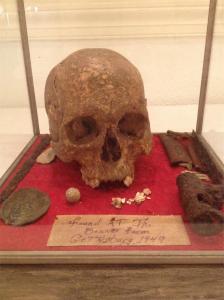
The edition of my copy.
I bought this 4 years ago, whilst I was reading ‘Ulysses’, but only read it at the beginning of this year, as after finishing the aforementioned epic last summer (I did take a 3 year break from it- it didn’t take me 4 years to read), I didn’t feel like approaching Joyce for a while. However, I am so glad that I did. So glad, indeed, that I devoured ‘A Portrait of the Artist as a Young Man’ immediately afterwards. But that’s for the next post. Suffice to say, I adore both that work and this one.
Having read ‘Ulysses’ first, I was pleasantly surprised just how readable the ‘Dubliners’ collection is, with the prose style being at turns simple and yet poetic, and actually intelligible. There is such an attention to detail in the stories that the reader is placed within the action (or more often the inaction) to an immersive extent, and the mundane lives of the characters are presented through a microscope. For example, take this line from ‘A Painful Case’:
One evening as he was about to put a morsel of corned beef and cabbage into his mouth his hand stopped. His eyes fixed themselves on a paragraph in the evening paper which he had propped against the water-carafe. He replaced the morsel of food on his plate and read the paragraph attentively. Then he drank a glass of water, pushed his plate to one side, doubled the paper down before him between his elbows and read the paragraph over and over again. The cabbage began to deposit a cold white grease on his plate. The girl came over to him to ask was his dinner not properly cooked. He said it was very good and ate a few mouthfuls of it with difficulty.
This is fairly representative of the collection as a whole, to be honest, but I do not mean this as a negative at all- I like this painfully close attention to detail. However, this attention to the minutiae of everyday Dublin existence does allow Joyce to neglect plot somewhat- or at least create plots that share this mundane and somewhat pedestrian social environment. I didn’t really notice this as I read the text, but have been increasingly aware of the fact while mulling over what I should write on this post. Looking at the plot summaries on Wikipedia, I am still none the wiser as to what I should write regarding the narrative substance of the tales.
This aside, the collection truly bewitched me as I read it, and I will most certainly read it again (partly so as I can attempt a closer understanding of the individual plots). I will also say that I missed some of the messages of the text which are left to the reader due to the unfinished nature of many of the plot strands of the stories, so will make more of an effort to look out for these next time too. To be fair, perhaps a better way of summing the book up would be as a collection of scenes or vignettes, rather than stories. If it is approached like this- with less expectation of narrative completeness- then perhaps the text works on a higher level. Nevertheless- I loved it as it was, with my confusion intact.
To finish off, here is my favourite line from the book, which incidentally is the final line of the closing story (or novella), ‘The Dead’:
His soul swooned slowly as he heard the snow falling faintly through the universe and faintly falling, like the descent of their last end, upon all the living and the dead.
Pure poetry, and a hint of things to come with regards to Joyce’s next work.












